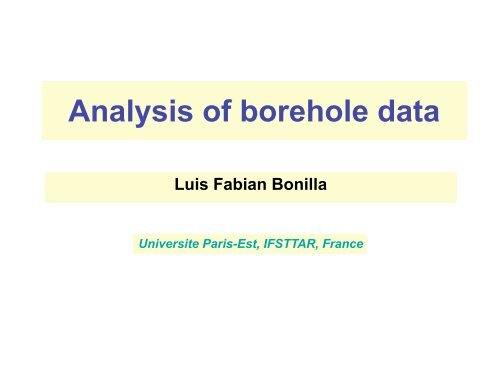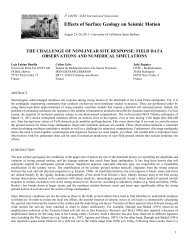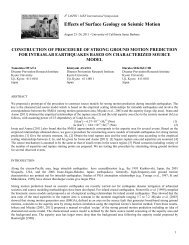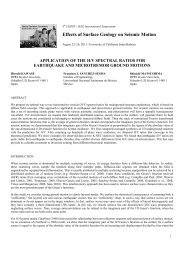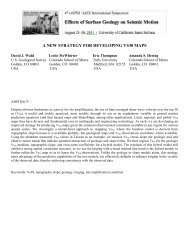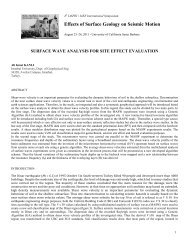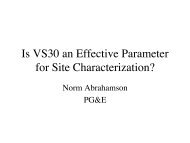Fabian Bonilla - ESG4 Conference @ UCSB
Fabian Bonilla - ESG4 Conference @ UCSB
Fabian Bonilla - ESG4 Conference @ UCSB
Create successful ePaper yourself
Turn your PDF publications into a flip-book with our unique Google optimized e-Paper software.
Analysis of borehole data<br />
Luis <strong>Fabian</strong> <strong>Bonilla</strong><br />
Universite Paris-Est, IFSTTAR, France
Outline<br />
• Advantages of borehole data<br />
• Difficulties of working with these data<br />
• Understanding linear and nonlinear<br />
modeling<br />
• Working proposition?
1. Advantages of borehole data<br />
Garner Valley - USA<br />
(Borehole Obs.)<br />
Wave propagation from bedrock to surface
PGA distribution<br />
(KiK-net)<br />
Field data observation of soil<br />
nonlinearity onset?<br />
Statistical analysis with<br />
respect to magnitude and<br />
Vs30
Calibration of soil models<br />
Stress computation from<br />
deformation data<br />
Waveform modeling
Revealing nonlinear response<br />
after <strong>Bonilla</strong> et al. (2011)<br />
• 2011 Tohoku earthquake data<br />
• Predominant frequency more affected than fundamental<br />
• Affected frequency increases as Vs30 increases
Port Island, Kobe / Kushiro Port<br />
Loose sand => liquefaction<br />
-Lowpass filtering<br />
-Deamplification<br />
Dense sand => cyclic mobility<br />
- High frequency peaks<br />
- Amplification<br />
Velocity model is not always enough!
2. Difficulties of borehole data<br />
Downgoing<br />
wavefield<br />
Site response (outcrop<br />
response) is not the<br />
same as borehole<br />
response
Vs30 uncertainty<br />
(lack of knowledge of<br />
the medium)<br />
• Variability within each<br />
soil class is important<br />
• This variability is even<br />
larger at depths greater<br />
than 30 m<br />
• Is Vs30 enough?<br />
• Not always core<br />
sampling, thus no<br />
dynamic soil parameters
Analysis of<br />
KiK-net<br />
boreholes<br />
• Similar Vs30<br />
(between 350 and<br />
450 m/s)<br />
• Different velocity<br />
distribution at depth<br />
• Different site<br />
response<br />
• Is Vs30 enough?<br />
After Regnier et al. (2010)
Vs30 = 400 +/- 5 m/s<br />
-"+(.,-/(0,1"2"'-(3455(<br />
'"2,$(=+(>2&?#"+()&2(=+*5(@(A55BC+(D3&E&'("-(7#F(G55HI(<br />
0<br />
Vs (m/s)<br />
500 1000 1500 2000 2500 3000<br />
IWTH07 C 800<br />
= 0.46<br />
After Regnier et al. (2010)<br />
20<br />
HRSH13 C 800<br />
= 0.49<br />
NGSH01 C 800<br />
= 0.65<br />
40<br />
NGNH03 C 800<br />
= 0.66<br />
NARH05 C = 0.69<br />
800<br />
YMGH02 C 800<br />
= 0.71<br />
60<br />
HRSH18 C 800<br />
= 0.78<br />
KMMH09 C 800<br />
= 0.82<br />
Depth(m)<br />
80<br />
100<br />
SZOH31 C = 0.86<br />
800<br />
KKWH07 C 800<br />
= 0.90<br />
HRSH01 C 800<br />
= 0.95<br />
AICH22 C 800<br />
= 1.11<br />
YMGH13 C 800<br />
= 1.20<br />
120<br />
KMMH13 C 800<br />
= 1.22<br />
YMTH10 C 800<br />
= 1.28<br />
(<br />
140<br />
160<br />
IKRH01 C 800<br />
= 1.36<br />
FKIH06 C 800<br />
= 1.37<br />
MYGH02 C 800<br />
= 1.49<br />
generic profil<br />
No comments!<br />
The data speak alone
3. We need to know well the linear response<br />
(example of the CORSSA array, Greece)<br />
1. H/V spectral ratio (noise data)<br />
2. H/V spectral ratio (earthquake data)<br />
3. Standard spectral ratio (borehole response)<br />
4. Borehole response inversion (velocity, thickness,<br />
and Q profiles)
8 -- 800.0*<br />
Inverting for nonlinear soil properties<br />
In the first and second layers, the values in parentheses are identified from the part just after the main parts of the mainshock records, and the values<br />
without parentheses are identified from the main parts. Asterisks indicate S-wave velocities based on the logging results, i.e., not identified here.<br />
170 F. De Martin, H. Kawase, and A. Modaressi-Farahmand Raz<br />
in the main part and the part just after the main part of the<br />
strong motion, vertically propagating S waves are dominant<br />
(a)<br />
Sand and gravel (b)<br />
Clay<br />
in the period range from 0.1 to 2.0 sec, while in the later<br />
Identified<br />
Equivalent linear part, horizontally 1 propagating waves 11 are 3, 5, 9dominant in the pe- 1<br />
10 4<br />
1 2<br />
~t the main part of the foreshock record<br />
A riod range longer than 0.7 sec, and vertically propagating S<br />
0.8<br />
0.8<br />
8<br />
the main part of the mainshock record O waves are still dominant in the shorter period range. For the<br />
just after the main part of the mainshock record m<br />
weak motion, 0.6 only the main part can be examined because 0.6<br />
of the small signal-to-noise ratios in other 7 parts. In the main<br />
1.0<br />
20<br />
0.4<br />
0.4<br />
part of the weak motion, vertically propagating S waves are<br />
0.8<br />
16<br />
6<br />
also dominant. 0.2 Inversion - sand<br />
0.2 Inversion - clay<br />
..q 0.6 I lllllll IIIIIIII<br />
12<br />
Inversion - gravel<br />
Vucetic and<br />
0.4 IIIlllll IIIitll<br />
~7<br />
Based on these Seed and results, Idriss (1970b) we decided to analyze these three Dorby (1991)<br />
8 > S-wave dominant 0 time segments, that is, the main part of the 0<br />
0.2<br />
IIIIIIll LtlI_'. -<br />
10 -6 10 -5 10<br />
4<br />
strong motion, the part just after -4 10 -3 10 -2 10 -6 10 -5 10<br />
the main part of the strong<br />
-4 10 -3 10 -2<br />
γ<br />
γ<br />
'--FI-fl-flff- I IIIIIll<br />
0.0 motion, and the main part of the weak motions, based on 1D<br />
10-4 10- 3 10- 2 10- 1 100 0<br />
Nonlinear Soil Behavior in Kashiwazaki-Kariwa Nuclear Power Plant during 2007 Earthquake 773<br />
Figure '-n<br />
o<br />
(a) First layer<br />
>.<br />
24. wave (a) Comparison propagation oftheory strain-dependent for vertically De characteristics propagating Martin inverted S et waves. al. for sand (2010) and gravel layers with laboratory test results for s<br />
1.0<br />
(Seed and Idriss,<br />
20 ,q<br />
The 1970b) observed whose spectral effective ratio vertical between stress KD2 rangesand fromKS2 0.05for to 0.5 the MPa. (b) Comparison of the strain-dependent characteris<br />
inverted for clay (a)<br />
< 0.8<br />
o main<br />
layers<br />
part<br />
with<br />
of the<br />
laboratory Surface<br />
strong<br />
test<br />
motion<br />
results Layer<br />
shows<br />
for clay<br />
a longer<br />
(Vucetic<br />
peak<br />
and Dobry, (b)<br />
period<br />
1991) whose plasticity Intermediate index Layer (PI) ranges from 0% to 200<br />
16 For both panel, numbers indicate layers of Table 3.<br />
0,6 t ll,,Jl,,I ,,,lll,Jt I<br />
with lower 1.4 amplitude at the peak around 0.5 sec compared 1.4<br />
12<br />
Empirical<br />
to the corresponding peak for the weak motions. The shift<br />
Relationship<br />
Earth Science and Disaster 1.2 Prevention (NIED). This work was performed based 1.2 on Lotung downhole ground motion data, in Proc. of<br />
041j r<br />
8<br />
120 Empirical<br />
while one of the<br />
02 I IIIIIJl lJ l-- llrllll I<br />
of authors the peak (F. period D. M.) was can abe visiting clearly scholar seen at in the the Relationship Disaster Fourier spectra 2nd Int. Conf. on Recent Advances in Geotechnical Earthqu<br />
140<br />
4 Prevention Research of the Institute, KS2 1.0 records. Kyoto, onTo leave quantify from Bureau this deperiod Recherches and amplitude Engineering 1.0 and Soil Dynamics, St. Louis, Missouri, 11–15 Ma<br />
o.of-FFIll-Itff-Tlflllltl I IIIIIIII I IIIIIIII Géologiques et Minières, Orléans. This work was supported by the CAR- 1991, 111–118.<br />
8070<br />
0<br />
shift, the S-wave velocities and the damping factors are iden-<br />
60<br />
60<br />
10 -4 10-3 10- 2 10-1 100 NOT Institute and the 21st 0.8 Century COE Program of Kyushu 100 University Chávez-García, 0.8 F. J., and D. Raptakis (2008). Inversion<br />
50<br />
of soil structure<br />
SHEAR STRAIN (%)<br />
(H-14). Drs. S. tified Parolai, by T. minimizing Satoh, and an anonymous the residual reviewer between madethe valuable observed spec- analysis of the seismic wavefield from a vertical array, in Proc. of<br />
80 50<br />
(b) Second layer<br />
suggestions totral improve ratio this 0.6and article. the theoretical amplification 90 70 factor calculated 14th 0.6 World Conf. on Earthquake Engineering, Beijing, 40 China, 12<br />
140<br />
from the 1D wave propagation theory. The S-wave velocity October 2008.<br />
0.4<br />
Figure 15. Relationships between the effective<br />
and the damping References<br />
Chin, B.-H., 0.4<br />
Fujisawa factor Sand<br />
and K. Aki (1991). Simultaneous study of the source, path,<br />
Disturbed Samples<br />
in the surface alluvial layer identified<br />
40<br />
site effects on strong ground motion during the 1989 Loma Pr<br />
shear strain and the shear modulus reduction ratio or for the main 0.2 part Undisturbed of the strong motion are about 10% smaller 0.2<br />
the Pioneering damping factor for (a) work the first layer by and T. (b) the Aguirre, J., and K. Irikura (1997). Samples Nonlinearity, liquefaction, and velocity earthquake: A preliminary result on pervasive nonlinear site effe<br />
and 50% greater, respectively, than those : void ratioidentified for the<br />
second layer are estimated by two methods. Solid variation of soft soil layers in Port Island, Kobe, during the Hyogo-ken Bull. Seismol. Soc. Am. 81, 1859–1884.<br />
0<br />
0<br />
symbols Satoh shows the since values based the on linear 90’s 1D theory Nanbu earthquake, main part Bull. 10 of -8 Seismol. the 10 -7 weak Soc. 10 motions. Am. -6 87, 101244–1258.<br />
-5 The 10relationships -4 -3 10between<br />
-2 Cramer, C., 10 -8 and 10 C. -7 Real 10 (1992). -6 A10 -5 statistical 10 -4 analysis 10 -3 of submitted 10 -2 s<br />
with the S-wave velocities and the damping factors Aki, K. (1993). the Local effective site effects shear onstrain weak and strong the shear groundmodulus motion, reduction effects predictions for the weak-motion blind prediction test condu<br />
Strain<br />
Strain<br />
estimated by the identification method. Open symbols Tectonophysics 218, 93–111.<br />
at the Turkey Flat, USA, site effects test area near Parkfield, Califor<br />
ratios or damping factors estimated by the identification<br />
show the values based on the equivalent linear 1D Aki, K. (2003). A perspective on the history of strong motion seismology, in Proc. of the Int. Symp. on the Effects of Surface Geology on Seis<br />
method agrees with the laboratory test results. We corrobtheory<br />
in which the S-wave velocities and the damp- Phys. Earth Planet. In. 137, 5–11. (c) Mogi et Base al. Motion, Layer (2010)<br />
Odawara City, Japan, Volume 2, 15–20.<br />
ing factor for the main part of the foreshock are used Archuleta, R. J., orate S. H. that Seale, the P. main V. Sangas, part L. of M. the Baker, strong andmotion, S. T. Swain whose Cultrera, maxi-<br />
1.4<br />
G. C., D. M. Boore, W. B. Joyner, and C. M. Dietel (19<br />
as initial values for iteration. The shear modulus re- (1992). Garner mum Valley acceleration downholeat array the ofsurface accelerometers: station Instrumentation<br />
and and preliminary whose data duration analysis, is Bull. 3 sec, Seismol. has Soc. the 1.2 potential Am. 82, 1592– of making the<br />
KS2 is 220 cm/sec Nonlinear 2 soil response in the vicinity of the Van Norman Comp<br />
duction<br />
• Use of vertical arrays<br />
ratio for the foreshock are assumed to be unity<br />
following the 1994 Northridge, California, earthquake, Bull. Seism<br />
and the damping factor to be 3.4% at the effective 1621.<br />
Soc. Am. 89, 1214–1231.<br />
surface soil nonlinear at an effective shear strain on the order<br />
50<br />
shear strain of 10-4%. Solid and dashed curves rep- Archuleta, R. J., S. H. Seale, P. V. Sangas, L. M. Baker, and 1.0 S. T. Swain Darragh, R. B., and A. 40F. Shakal (1991). The site response of two rock<br />
• Inversion of G/Gmax<br />
resent the shear modulus reduction ratios and the (1993). Garner of 0.1%. only<br />
7060<br />
valley downhole array of accelerometers: Instrumentation<br />
and preliminary The S-wave data analysis, velocities Bull. Seismol. in the Soc. alluvial 0.8Am. 83, layers 2039. identified Am. 81, 1885–1899.<br />
soil station pairs to strong and weak ground motion, Bull. Seismol. S<br />
damping factors as a function of the effective shear<br />
strain given by JESG (1991) from laboratory tests. Asano, K., and from T. Iwata the (2006). part just Source after process the main and near-source part of the ground strong motion Field, E. H., P. A. Johnson, I. A. Beresnev, and Y. Zeng (1997). Nonlin<br />
motions of the 2005 West Off Fukuoka Prefecture earthquake, 0.6 Earth ground-motion amplification by sediments during the 1994 Northri<br />
G/G max<br />
G/G max<br />
PI = 0%<br />
PI = 200%
Inverting for nonlinear soil properties<br />
D. Assimaki et al. Pure Appl. Geophys.<br />
A Wavelet-based Seismogram Inversion Algorithm for the In Situ Characterization of Nonlinear Soil Behavior<br />
Figure 18<br />
Best fit nonlinear cyclic soil response predicted at convergence of the proposed inversion using the six-parameter model at the midpoint<br />
between consecutive receivers of the DHB downhole array in Lotung (LSST): 0–6, 6–11, and 11–17 m. Comparison of results with previously<br />
Assimaki et al. (2010)<br />
Figure 17<br />
rray instrumentation of Lotung LSST experiment site (modified from ANDERSON, 1993), b shear wave velocity profile (V s ) at<br />
adopted from ELGAMAL et al. (2001). Density used in the nonlinear soil response inversion was q = 2 tn/m 3 and attenuation<br />
factor Q = 10<br />
motions ranging from medium to high intensity were<br />
shown to converge to consistent nonlinear properties.<br />
The target best fit model was defined as the average<br />
modulus reduction and damping curves across the<br />
Table 5 ensemble of ground motions used. The inversion was<br />
next employed on field data at a downhole array site,<br />
corded events at the LSST downhole array used in the inversion of seismogram and results were recordings shown to (from compare GLASER, very1995)<br />
well with<br />
published data on generic soil conditions. Results<br />
ate Magnitude (Ml) Epicenter from Focal thisdepth work (km) advance thePeak stateAcceleration of the art in in[gals]<br />
situ<br />
strong motion site response inversion, where the soil<br />
Longitude (E) Latitude (N)<br />
is for the most part approximated<br />
E–W<br />
by an<br />
N–S<br />
equivalent<br />
V<br />
obtained inversion data at the same site (ZEGHAL et al., 1996; ELGAMAL, 1995) and nonlinear dynamic soil properties proposed by EPRI (1993)<br />
for the corresponding profile depths<br />
Inverting for G/Gmax and damping ratio<br />
nonlinear site response during future events. The<br />
authors are currently extending the formulation to<br />
multilayered 1D profiles with a downhole and surface<br />
receiver, and in the future will be working to implement<br />
the proposed inversion for 3D near-surface soil<br />
formations and non-destructively extract inelastic soil<br />
characteristics from active surface vibration sources<br />
(i.e., Spectral Analysis of Surface Waves).<br />
Acknowledgments
25.4 5634 0.56 30<br />
10 72 3.51 8<br />
21 180 2.32 18<br />
For each case study, the soil response and the soil-structure interaction are studied. The soil<br />
response of the three different soil profiles are presented in §5.3. The soil-structure interaction is<br />
An<br />
studied<br />
insight §5.4. Different indexes<br />
of<br />
and<br />
nonlinear<br />
control points are defined to simplify<br />
soil<br />
the way<br />
response<br />
the results<br />
are displayed. Figure 5.8 shows these indexes and the control points in the model.<br />
able 5.1: Properties of the three selected buildings ts<br />
perties<br />
ff<br />
P o.A<br />
sb<br />
a<br />
a/2<br />
P o.B<br />
P o.C<br />
a<br />
Foundation length<br />
files are considered to represent different level of nonlinearities. 110 The Chapter soil 5. Effect of soil nonlinearity<br />
different layers. The geometry and elastic properties of these soil profiles<br />
Figure 5.8: Definition of the control points of the soil-structure models<br />
.<br />
g/m 3<br />
m/s<br />
10m<br />
Soil-structure interaction model<br />
ff represents the free field, ts the top of the structure, out the outcropping and sb the base<br />
of the soil profile. The control points P o.A, P o.B and P o.C represents the points where we<br />
ρ<br />
will study the 1 = 1930kg/m<br />
soil and structure 3<br />
!5<br />
ρ<br />
responses. The parameter 1 = 1930kg/m<br />
a is the 3<br />
length of the foundation.<br />
V s1 = 220m/s<br />
10m<br />
1<br />
2<br />
3<br />
0<br />
V s1 = !10 185m/s<br />
out<br />
Gandomzadeh (2011)<br />
Soil profile 1<br />
Soil profile 2<br />
Soil profile 3<br />
!15<br />
g/m 3<br />
m/s<br />
20m<br />
ρ 2 = 1980kg/m 3<br />
V s2 = 400m/s<br />
20m<br />
ρ 2 = 1940kg/m !20<br />
3<br />
Depth (m)<br />
V s2 =<br />
!25<br />
335m/s<br />
!30<br />
Depth (m)<br />
g/m 3<br />
m/s<br />
20m<br />
ρ 3 = 2040kg/m 3<br />
V s3 = 550m/s<br />
20m<br />
ρ 3 = 2000kg/m !35 3<br />
V s3 = !40 460m/s<br />
!45<br />
g/m 3<br />
m/s<br />
ρ = 2100kg/m 3<br />
V s = 800m/s<br />
ρ = 2100kg/m !50<br />
3<br />
0 200 400 600 800 1000<br />
V s = 800m/s<br />
Shear Modulus (MPa)<br />
1)<br />
(b) Soil profile (#2)<br />
(c) Soil profile (a) (#3) Low-strain shear moduli of the profiles<br />
(b)<br />
Confining pressure dependency<br />
ometric and material properties of the three selected soilFigure profiles 5.3: Low-strain shear moduli and elastic shear
shift of the fundamental frequency of the soil-structureshear system components. when soilFor example, Figure 5.32 displays the iso-values of the cumulative dissipated<br />
is acting is quite low. Numerical simulations show this is not energy a good in the index soil, tofor three soil-structure systems (Case studies 2, 5 and 8) at the end of the<br />
computation. The dissipated energy presented here is only due to the shear terms. These<br />
structures are based on the second soil profile, and the input motion of 0.25g outcropping PGA<br />
is applied at the base of the model after its division by two.<br />
.2.5 Case studies<br />
hree different structures and three different soil profiles are considered. Consequently, we have<br />
from nonlinear<br />
An<br />
behavior.<br />
insight<br />
However, the amplitude<br />
of<br />
may be<br />
nonlinear<br />
more discriminant.<br />
soil response<br />
terial behavior is assumed linear, consequently, the aforementioned remark<br />
different case studies. For each case, one linear and four nonlinear analyses (with the input<br />
otions presented in §5.2.3) are performed. Therefore, our parametric study consists of 45<br />
ifferent analyses. Table 5.5 displays the properties of each case study.<br />
ering For eacha case nonlinear study, the soil structure.<br />
response and the soil-structure interaction are studied. The soil<br />
esponse of the three different soil profiles are presented in §5.3. The soil-structure interaction is<br />
tudied in §5.4. Different indexes and control points are defined to simplify the way the results<br />
re displayed. Figure 5.8 shows these indexes and the control points in the model.<br />
dissipation in the soil and maximum strain during<br />
out<br />
pagation<br />
ts<br />
dissipation<br />
ff<br />
P o.A<br />
a<br />
P o.B<br />
a/2<br />
P o.C<br />
a<br />
2<br />
y the role of the different energy dissipation mechanisms in the problem and<br />
Foundation length<br />
f soil nonlinearity on SSI, the dissipated3<br />
energy due to the hysteresis behavior<br />
sb<br />
1<br />
computed during the wave propagation. For the soil, an energy dissipation<br />
0.<br />
2.5<br />
uted by<br />
.5<br />
3.<br />
136 Chapter 5. Effect of soil nonlinearity on dynamic<br />
1.<br />
SSI : Parametric3.5<br />
study<br />
Figure 5.8: Definition of the control points of the soil-structure models<br />
I soil = 1 ∫ ∫<br />
1.5<br />
4.<br />
σ(x,t):dɛ(x,t)dV (5.3)<br />
2.<br />
4.5<br />
Ω<br />
2.5<br />
5.<br />
bottom boundary of the soil layers and also close to the surface was described before in §5.5.1.<br />
(d) Legend: (J/m 3 )<br />
We observe that at these areas the maximum shear strain is in accordance with the dissipated<br />
energy Figureand 5.32: is larger Cumulative than other dissipated parts. energy at the end of the wave propagation due to the shear<br />
components of the stress 0.2g and strains for case studies 2, 5 and 8 obtained 0.7gfor<br />
the 0.25g outcropping<br />
PGA<br />
ff represents the free field, ts the top of the structure, out the outcropping and sb the base<br />
f the soil profile. The control points<br />
Ω<br />
P o.A,<br />
t<br />
P o.B and P o.C represents the points where we<br />
ill study the soil and structure responses. The parameter a is the length of the foundation. (c) Dissipated energy (b03 and soil profile #2)<br />
Dissipated energy is<br />
higher at interfaces<br />
and close to the free<br />
surface<br />
(a) Dissipated energy (b01 and soil profile #2) (b) Dissipated energy (b02 and soil profile #2)<br />
0<br />
!5<br />
!5<br />
!5<br />
!5<br />
These graphs help us to find the parts of the soil mediumPo.C<br />
that dissipate more energy during<br />
the wave propagation. The parts that are white in this figure dissipate more than 5J/m 3<br />
!10<br />
!10<br />
!10<br />
!10<br />
energy. We observe that the soil energy is strongly dissipated at the bottom boundary of each<br />
!15<br />
!15<br />
!15<br />
!15<br />
layer and also close to the surface where the up and downgoing waves are combined. Firstly,<br />
!20<br />
!20<br />
!20<br />
!20<br />
the shear modulus reduction curve is related to the confinement stress (equation 5.1), therefore<br />
the!25soil becomes softer by!25<br />
getting closer to the surface. !25 Secondly, the properties !25 of each layer is<br />
weaker than the one below it. Consequently, more energy dissipation is observed at the bottom<br />
!30<br />
!30<br />
!30<br />
!30<br />
boundary of each soil layer. Thirdly, the impedance contrast is higher at the boundary between<br />
layers, !35 thus amplification!35<br />
is also produced, which!35competes with nonlinear !35 effects.<br />
The effect of the structure weight on the low-strain shear modulus is taken into account (see<br />
!40<br />
!40<br />
!40<br />
!40<br />
1.6.4). This may change the nonlinear behavior of the soil particularly around the foundation.<br />
free field<br />
free field<br />
free field<br />
!45<br />
Po.A<br />
!45<br />
Po.A<br />
!45<br />
!45<br />
Po.A<br />
In this work, we neglected the effect of initial static condition. This effect changes the behavior<br />
Po.B<br />
Po.B<br />
Po.B<br />
Po.C<br />
Po.C<br />
Po.C<br />
of !50 the soil before applying!50<br />
the dynamic loading. In !50 addition, the weight !50 of the structure and soil<br />
0 0.2 0.4<br />
I<br />
produces soil<br />
(J/m<br />
the 3 0 2 4 6<br />
0 50 100<br />
)<br />
settlement in theShear media strain (%) that x 10 we did not study in our work. Therefore, the effect<br />
!3<br />
I soil<br />
(J/m 3 0 0.02 0.04 0.06<br />
)<br />
Shear strain (%)<br />
Depth<br />
Depth<br />
0<br />
Depth<br />
0<br />
free field<br />
Po.A<br />
Po.B<br />
Depth<br />
0<br />
Gandomzadeh (2011)<br />
(a) Dissipated energy<br />
(b) Maximum shear strain<br />
(c) Dissipated energy<br />
(d) Maximum shear strain<br />
Figure 5.36: Maximum shear strain reached during the calculation and the dissipated energy due<br />
to the stress and strain shear components for the case study 2 with two 0.1g (two left figures
What do we observe?<br />
• Energy is strongly dissipated at the bottom of each<br />
layer and close to the free surface<br />
• Since shear strength increases with depth, the<br />
energy is dissipated in the weaker part (transition<br />
between layers)<br />
• Furthermore, the impedance contrast increases at<br />
each layer interface<br />
• Thus, nonlinear response has a cumulative effect<br />
(number of cycles) and competition between<br />
impedance contrast (linear part) and material<br />
strength (nonlinear part)<br />
• It is therefore necessary to instrument not only the<br />
middle of the layers but near their interfaces
Conclusions<br />
Sources of uncertainty (variability) in site response<br />
• Input ground motion (e.g. near- and far-field)<br />
• Low strain properties (linear site response)<br />
• Dynamic soil properties (nonlinear site response)<br />
• Methods of computing site response<br />
What do we need?<br />
• Understanding linear site response<br />
• Inverting earthquake data to obtain dynamical soil<br />
properties (up to bedrock?)<br />
• Core sampling and laboratory tests (material<br />
strength, granulometry, pore pressure effects, etc.)<br />
• Instrumenting middle of layers and near their<br />
interfaces


